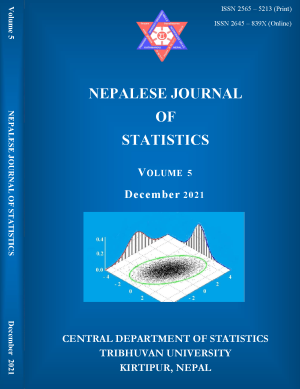Negative Binomial Distribution to Explain the Domestic Fire Incidence in Nepal
DOI:
https://doi.org/10.3126/njs.v5i1.41229Keywords:
Domestic fire incidence, negative binomial distribution, Akaike Information Criteria, Bayesian Information Criteria, P-P plot, Q-Q plotAbstract
Background: Fire disaster is one of the most destructive disasters. According to global dataset of Sendai Framework, domestic fire incidence was 9.9% up to 2019. In Nepal, 62% fire incidence was reported during 2017 and 2018. However, many studies have been conducted on fire incidence, few of them are based on domestic fire incidence.
Objective: To find the descriptive statistics of fire occurrences and fire fatalities, and to identify the probability distributions that best fit the data of fire occurrences observed in three ecological regions as well as overall in Nepal.
Material and Methods: The data of fire incidences from May 2011 to April 2021 were retrieved from Nepal Disaster Risk Reduction Portal, Government of Nepal. At first, a statistical software "Mathwave EasyFit" of 30 days trial version was used to identify the candidate probability models. Further, the best probability model was determined after testing the goodness of fit of the candidate models by using graphical tools-histogram and theoretical densities, empirical and theoretical CDFs, Q-Q plot and P-P plot; and mathematical tools-maximum likelihood, Akaike Information Criteria and Bayesian Information Criteria by using the package “fitdistrplus” of software R version 4.1.1.
Results: On an average, 135 fire incidences per month were occurred in Nepal. However, the Terai faced the highest monthly fire incidences compared to the Hill and the Mountain, it has less fatality per 100 fire incidence followed by the Hill and the Mountain. Descriptive statistics reveals that fire occurrences are moderate during November to February and high in March and April. The fire incidences were reported high during spring and winter and low during summer and autumn season which reveals that fire incidence might be related with the precipitation and temperature. The sample data was run in "Mathwave EasyFit" software which suggested Poisson, geometric and negative binomial distribution as candidate probability models. The goodness of fit of these models were further tested by graphical as well as mathematical tools where negative binomial distribution was found to be best among the candidate models for the data set.
Conclusion: Incidence of fire disasters varies by ecological regions as well as by seasons. It is low in the Mountain region and during Monsoon/rainy season. Negative binomial distribution fits the best to monthly data of fire incidence in Nepal.
Downloads
Downloads
Published
How to Cite
Issue
Section
License
© Central Department of Statistics, Tribhuvan University, Kirtipur, Kathmandu, Nepal
The author of article must sign the copyright permission or the author must assign copyright to the Central Department of Statistics, Tribhuvan University prior to publication.
All rights reserved.




